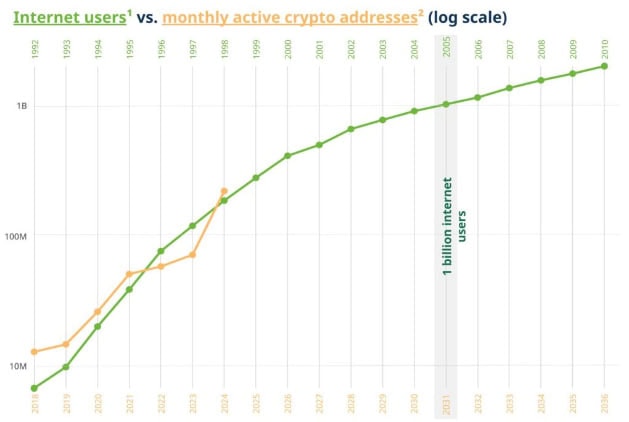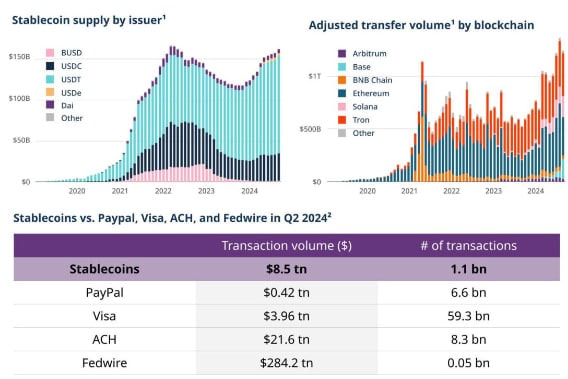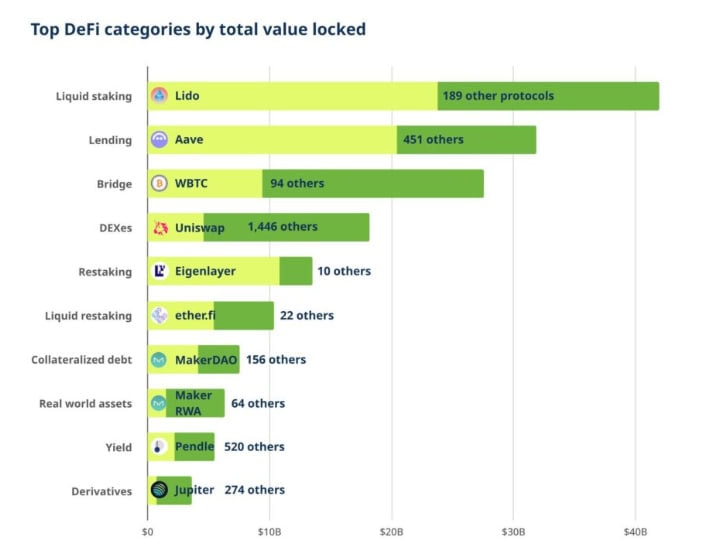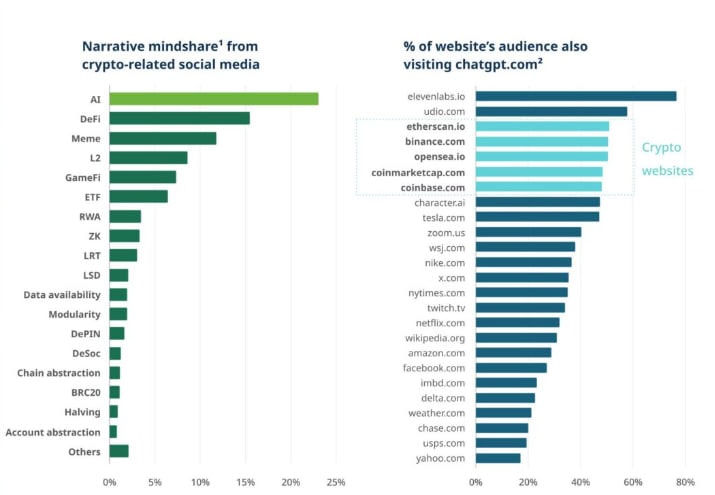a16z Report: Cryptocurrency Activity Reaches All-Time High
- a16z has published a report on the state of cryptocurrencies in 2024.
- Experts said that the monthly number of active crypto addresses has reached ATH.
- They also touched on the issue of regulation of the sector.
Venture capital firm Andreessen Horowitz (a16z) has published a report on the cryptocurrency sector in 2024. In it, analysts looked at activity in the industry, its role in politics, stablecoins, DeFi, and much more.
Cryptocurrency Sector Activity Reaches All-Time High
According to experts, the monthly number of active crypto addresses has reached an all-time high (ATH). In September 2024, 220 million addresses interacted with the blockchain at least once, more than three times more than at the end of last year.
Analysts attribute the overall activity growth to the Solana blockchain, which accounted for about 100 million active addresses. Next comes NEAR with 31 million, Base - 22 million, TRON - 14 million, the Bitcoin network - 11 million, BNBChain - 10 million, Ethereum - 6 million.
The number of mobile crypto wallet users reached 29 million in June 2024, breaking the ATH. The United States is the largest user of crypto wallets, accounting for 12% of the total, but the country's user base has declined due to regulation, the document says. Nigeria, India, and Argentina are next in line.
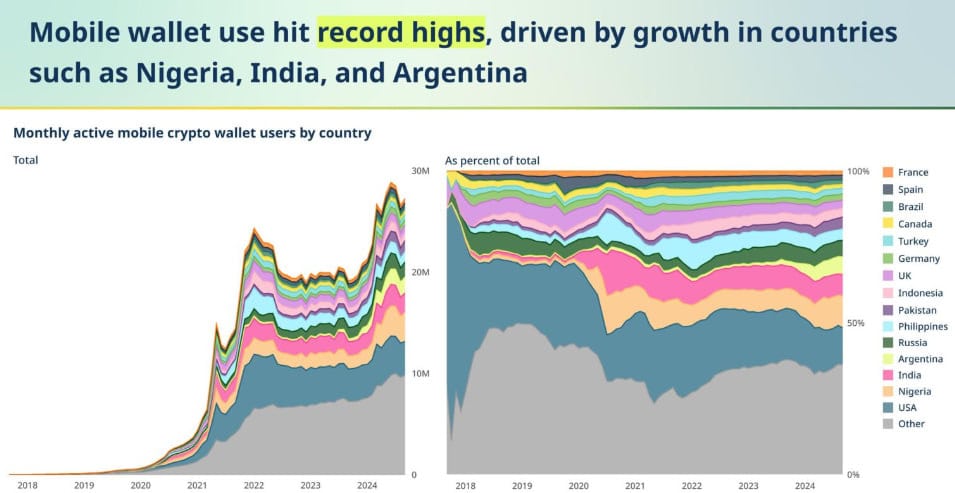
The report notes that there are 617 million crypto asset owners worldwide, with between 30 and 60 million remaining active each month.
Cryptocurrencies and Politics
Experts said that US states such as North Dakota, Arkansas and Minnesota have seen the biggest increase in interest in cryptocurrencies since the last presidential election in 2020.
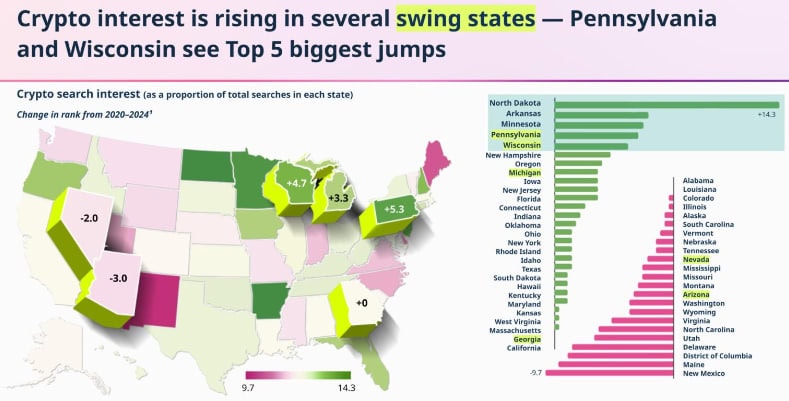
“One factor that may have increased public interest in cryptocurrencies this year was the launch of Bitcoin and Ethereum-based exchange-traded funds (ETFs). The number of Americans owning cryptocurrencies could grow as these ETFs expand investors’ access to crypto assets. Together, these products already store $65 billion,” the document says.
a16z also added that more and more politicians are speaking positively about cryptocurrencies.
In addition, experts said that the European Union and the United Kingdom have been the most active in engaging the public on cryptocurrency policy and regulation. According to their data, European agencies have issued far more requests than, for example, the U.S. Securities and Exchange Commission.
The report notes that stablecoins have become one of the most popular crypto products and are one of the biggest topics of political debate as governments realize that these assets can strengthen the position of the US dollar abroad. Analysts expect that more countries will soon begin to seriously specify their cryptocurrency policies and strategies.
Stablecoins
A16z said stablecoins have dramatically reduced the cost of executing crypto transactions, in some cases by more than 99%. On Ethereum, transactions using USDC cost an average of $1 in September. On the Base network, the costs averaged less than a cent. The experts compared that in the U.S., the fee for international bank transfers was about $44.
Congressman Ritchie Torres stated:
"The proliferation of dollar-denominated stablecoins could be the greatest experiment in financial empowerment humanity has ever undertaken."
In Q2 2024, users made more than 1.1 billion transactions using stablecoins worth about $8.5 trillion. This is twice as much as with the Visa payment system, where the figure was $3.9 trillion.
Experts added that stablecoins account for almost a third of daily cryptocurrency usage, second only to the DeFi sector.
Infrastructure development
One of the reasons stablecoins have become so popular and easy to use is the development of the underlying infrastructure, a16z said. The report said blockchains now process more than 50 times more transactions per second than they did four years ago, thanks to the proliferation of layer-2 networks based on Ethereum and other high-performance blockchains.
A16z noted the Dencun update, which led to a reduction in fees in L2 networks. In other words, blockchains are becoming more popular and efficient at once, the experts added.
They also spoke positively about Zero-Knowledge Proof (ZKP) technology:
"ZKP technology is extremely promising as it opens up new avenues for developers to achieve low-cost blockchain computing. However, ZK-based virtual machines (zkEVMs) have a long way to go before they can match the performance of traditional computers - a humbling observation worth noting," the analysts said.
DeFi Sector
The report says that the only category that attracts developers more than blockchain infrastructure is decentralized finance (DeFi). According to a16z, decentralized exchanges have accounted for 10% of spot trading volume since their emergence in 2020. More than $169 billion is currently locked in DeFi protocols, including staking.
The analysts added that since Ethereum switched to a Proof-of-Stake consensus mechanism, the amount of assets staked has grown from 11% to 29% in two years.
“While DeFi is still in its early stages, it presents a promising alternative to the trend of centralization and consolidation of power that has plagued the U.S. financial system, where the number of banks has fallen by two-thirds since 1990,” the paper says.
Cryptocurrencies and AI
Artificial intelligence (AI) is one of the most discussed trends among crypto influencers on social media, according to a16z. Analysts noted that many visitors to cryptocurrency resources use the chatbot ChatGPT.
The report says that about a third of crypto projects, or 34%, claim to use artificial intelligence, regardless of the category in which they develop solutions.
“AI’s problems with centralization are almost the opposite of the decentralization opportunities that blockchains offer. Crypto projects are already trying to solve some of these problems today, with Gensyn democratizing access to AI computing, Story tracking IP, NEAR running AI on open-source protocols, and Starling Labs helping verify the authenticity and provenance of digital media,” the experts said.
Expansion of the cryptocurrency sector
The analysts said that as transaction costs fall and blockchain capacity increases, new opportunities are opening up for users. The report cites NFTs as an example.
"Years ago, cryptocurrency transactions were much more expensive, and people traded NFTs on secondary markets for large amounts. Now they can mint low-cost NFTs on social apps like Zora and Rodeo. This is a significant shift in the NFT market," the document says.
The experts also noted that in 2024, 10.3% of crypto projects were related to social resources. In addition, they emphasized the scaling of games on the blockchain.
Conclusion
A16z said that the cryptocurrency landscape has seen significant advances in policy, technology, consumer acceptance, and more over the past year. Specifically, analysts noted the launch of Bitcoin and Ethereum-based ETFs, major infrastructure improvements, the creation of new apps, the growth of the GameFi sector, and more.
“Whether we have entered the fifth innovation cycle remains to be seen. Either way, the crypto industry has made undeniable progress over the past year. And as ChatGPT has proven, it only takes one breakthrough product to change an entire industry,” the experts concluded.

